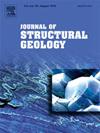Microstructure of garnet in calc-silicate rocks from Cheongsong, South Korea: Effects of fluid and deformation
IF 2.9
2区 地球科学
Q2 GEOSCIENCES, MULTIDISCIPLINARY
引用次数: 0
Abstract
Garnet is a common mineral found in metamorphic rocks of various lithologies in the continental basement, subducting slab, and upper mantle. In such environments, fluid–rock interactions, metamorphism, and deformation occur dynamically, disrupting garnet chemical distribution and its microstructure. Investigating the garnet microstructure in fluid-rich environments provides key insights into the role of fluids in the deep crust. In this study, the garnet microstructure in calc-silicate rocks from Cheongsong, South Korea, was analyzed to elucidate its petrofabric evolution during contact metamorphism and concurrent plastic deformation. Three garnet types were categorized based on their microstructures using scanning electron microscopy, electron backscattered diffraction, and electron microprobe analysis. Type I garnet is characterized by garnet clusters formed by multiple nucleation and coalescence at the preferred nucleation site. Type II garnet shows intense deformation due to dislocation creep. Type III garnet exhibits chemically zoned structures with light-colored garnet surrounding dark fragmented garnet, interpreted as fractured relict garnet partly dissolved and replaced by Fe-richer garnet. Transmission electron microscopy images of types II and III garnet showed evidence of dislocation creep. Deformation temperatures were estimated using the quartz c-axis fabric opening angle thermometer, ranging from 708 to 741 ± 50 °C. Considering the water-rich environment and metamorphic mineral assemblage, the actual deformation temperature of calc-silicate rock is suggested to be approximately 650–700 °C, consistent with garnet plastic deformation conditions. The nucleation and deformation processes of garnet suggested in this study provide insights into the petrogenesis and tectonometamorphic processes in contact-metamorphosed rocks within fluid-rich environments.
青松钙硅酸盐岩石中石榴石的微观结构:流体和变形的影响
石榴石是一种常见的矿物,存在于大陆基底、俯冲板块和上地幔的各种岩性的变质岩中。在这样的环境中,流体-岩石相互作用、变质作用和变形动态发生,破坏了石榴石的化学分布和微观结构。研究富流体环境中石榴石的微观结构为了解流体在地壳深处的作用提供了关键的见解。本文对韩国青松地区钙硅酸盐岩石中的石榴石微观结构进行了分析,以阐明其在接触变质作用和同期塑性变形过程中的岩组构演化。通过扫描电镜、电子背散射衍射和电子探针分析,对石榴石的显微结构进行了分类。I型石榴石的特征是在首选成核位置由多次成核和聚结形成的石榴石团簇。II型石榴石由于位错蠕变表现出强烈的变形。III型石榴石呈化学分带结构,浅色石榴石包裹着深色碎裂的石榴石,解释为碎裂的残余石榴石部分溶解,被富铁石榴石取代。II型和III型石榴石的透射电镜图像显示位错蠕变的证据。使用石英C轴织物开口角度温度计估计变形温度,范围为708至741±50°C。考虑富水环境和变质矿物组合,钙硅酸盐岩石的实际变形温度约为650 ~ 700℃,符合石榴石塑性变形条件。本研究提出的石榴石成核和变形过程为富流体环境中接触变质岩的岩石成因和构造变质过程提供了新的认识。
本文章由计算机程序翻译,如有差异,请以英文原文为准。
求助全文
约1分钟内获得全文
求助全文
来源期刊

Journal of Structural Geology
地学-地球科学综合
CiteScore
6.00
自引率
19.40%
发文量
192
审稿时长
15.7 weeks
期刊介绍:
The Journal of Structural Geology publishes process-oriented investigations about structural geology using appropriate combinations of analog and digital field data, seismic reflection data, satellite-derived data, geometric analysis, kinematic analysis, laboratory experiments, computer visualizations, and analogue or numerical modelling on all scales. Contributions are encouraged to draw perspectives from rheology, rock mechanics, geophysics,metamorphism, sedimentology, petroleum geology, economic geology, geodynamics, planetary geology, tectonics and neotectonics to provide a more powerful understanding of deformation processes and systems. Given the visual nature of the discipline, supplementary materials that portray the data and analysis in 3-D or quasi 3-D manners, including the use of videos, and/or graphical abstracts can significantly strengthen the impact of contributions.
 求助内容:
求助内容: 应助结果提醒方式:
应助结果提醒方式:


